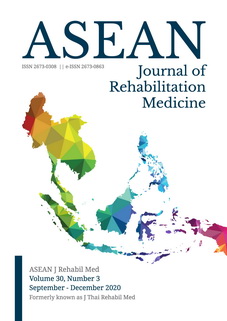The Effect of Obesity on Thoracolumbar Flexion Control of Jewett Hyperextension Brace
Keywords:
obesity, spine, orthotic devices, braceAbstract
Objectives: To investigate the effect of obesity on thoracolumbar flexion control of Jewett hyperextension brace.
Study design: Experiment study
Setting: King Chulalongkorn Memorial Hospital, Bangkok, Thailand
Subjects: Fifty healthy volunteers
Methods: Volunteers were stratified into obese and non-obese groups. After wearing the prefabricated Jewett hyperextension brace with adjustment performed by a certified prosthetist orthotist (CPO), the lateral plain TL film was done in a standing upright and in a force, trunk bending against the Jewett brace. The lateral Cobb angles from T9 to L3 were measured and the result was the difference of angle between standing and bending.
Results: The obese group had a significantly higher mean flexion angle than the non-obese group in all positions [in an upright position: 9.73 (SD 6.14) and 3.35 (SD 5.32) degrees, p < 0.001; and in the force flexion position: 17.89 (SD 8.09) and 12.80 (SD 6.84) degrees, p = 0.026]. The mean bendable angle after applying the brace were 9.45 (SD 5.80) degrees in the non-obese group and 8.13 (SD 6.53) degrees in the obese group and were not statistically different.
Conclusion: Obese volunteers had a significantly higher truncal flexion angle compared with the non-obese groups in all positions. The Jewett brace could control the spinal flexion movement to less than 10 degrees and not significant different between groups.
Keywords: obesity, spine, orthotic devices, brace
References
Cholewicki J, Alvi K, Silfies SP, Bartolomei J. Comparison of motion restriction and trunk stiffness provided by three thoracolumbosacral orthoses (TLSOs). J Spinal Disord Tech. 2003;16:461-8.
Vander Kooi D, Abad G, Basford JR, Maus TP, Yaszemski MJ, Kaufman KR. Lumbar spine stabilization with a thoracolumbosacral orthosis: evaluation with video fluoroscopy. Spine. 2004;29: 100-4.
Patwardhan AG, Li SP, Gavin T, Lorenz M, Meade KP, Zindrick M. Orthotic stabilization of thoracolumbar injuries. A biomechanical analysis of the Jewett hyperextension orthosis. Spine. 1990;15: 654-61.
van Leeuwen PJ, Bos RP, Derksen JC, de Vries J. Assessment of spinal movement reduction by thoraco-lumbar-sacral orthoses. J Rehabil Res Dev. 2000;37:395-403.
Ohana N, Sheinis D, Rath E, Sasson A, Atar D. Is there a need for lumbar orthosis in mild compression fractures of the thoracolumbar spine?: A retrospective study comparing the radiographic results between early ambulation with and without lumbar orthosis. J Spinal Disord. 2000;13:305-8.
Abudou M, Chen X, Kong X, Wu T. Surgical versus non-surgical treatment for thoracolumbar burst fractures without neurological deficit. Cochrane Database Syst Rev. 2013;CD005079. doi:10.1002/14651858.CD005079.pub3
Giele BM, Wiertsema SH, Beelen A, van der Schaaf M, Lucas C, Been HD, et al. No evidence for the effectiveness of bracing in patients with thoracolumbar fractures. Acta Orthop. 2009;80:226-32.
Rajasekaran S, Kanna RM, Shetty AP. Management of thoracolumbar spine trauma: an overview. Indian J Orthop. 2015;49:72-82.
Weitzman G. Treatment of stable thoracolumbar spine compression fractures by early ambulation. Clin Orthop Relat Res. 1971;76:116-22.
Folman Y, Gepstein R. Late outcome of nonoperative management of thoracolumbar vertebral wedge fractures. J Orthop Trauma. 2003;17:190-2.
Agabegi SS, Asghar FA, Herkowitz HN. Spinal orthoses. J Am Acad Orthop Surg. 2010;18:657-67.
WHO Expert Consultation. Appropriate body-mass index for Asian populations and its implications for policy and intervention strategies. Lancet. 2004;363:157-63.
Nishida C, Ko GT, Kumanyika S. Body fat distribution and noncommunicable diseases in populations: overview of the 2008 WHO Expert Consultation on Waist Circumference and Waist-Hip Ratio. Eur J Clin Nutr. 2010;64:2-5.
Browning LM, Hsieh SD, Ashwell M. A systematic review of waist-to-height ratio as a screening tool for the prediction of cardiovascular disease and diabetes: 0.5 could be a suitable global boundary value. Nutr Res Rev. 2010;23:247-69.
Berker D, Koparal S, Isik S, Pasaoglu L, Aydin Y, Erol K, et al. Compatibility of different methods for the measurement of visceral fat in different body mass index strata. Diagn Interv Radiol. 2010; 16:99-105.
Shirazi-Adl A, El-Rich M, Pop DG, Parnianpour M. Spinal muscle forces, internal loads and stability in standing under various postures and loads-application of kinematics-based algorithm. Eur Spine J. 2005;14:381-92.
Miller RA, Hardcastle P, Renwick SE. Lower spinal mobility and external immobilization in the normal and pathologic condition. Orthop Rev. 1992;21:753-7.
Simon S, Davis M, Odhner D, Udupa J, Winkelstein B. CT imaging techniques for describing motions of the cervicothoracic junction and cervical spine during flexion, extension, and cervical traction. Spine. 2006;31:44-50.
Jinkins JR, Dworkin JS, Damadian RV. Upright, weight-bearing, dynamic-kinetic MRI of the spine: initial results. Eur Radiol 2005; 15:1815-25.
Li G, Wang S, Passias P, Xia Q, Li G, Wood K. Segmental in vivo vertebral motion during functional human lumbar spine activities. Eur Spine J. 2009;18:1013-21.
Breen AC, Allen R, Morris A. Spine kinematics: a digital videofluoroscopic technique. J Biomed Eng. 1989;11:224-8.






